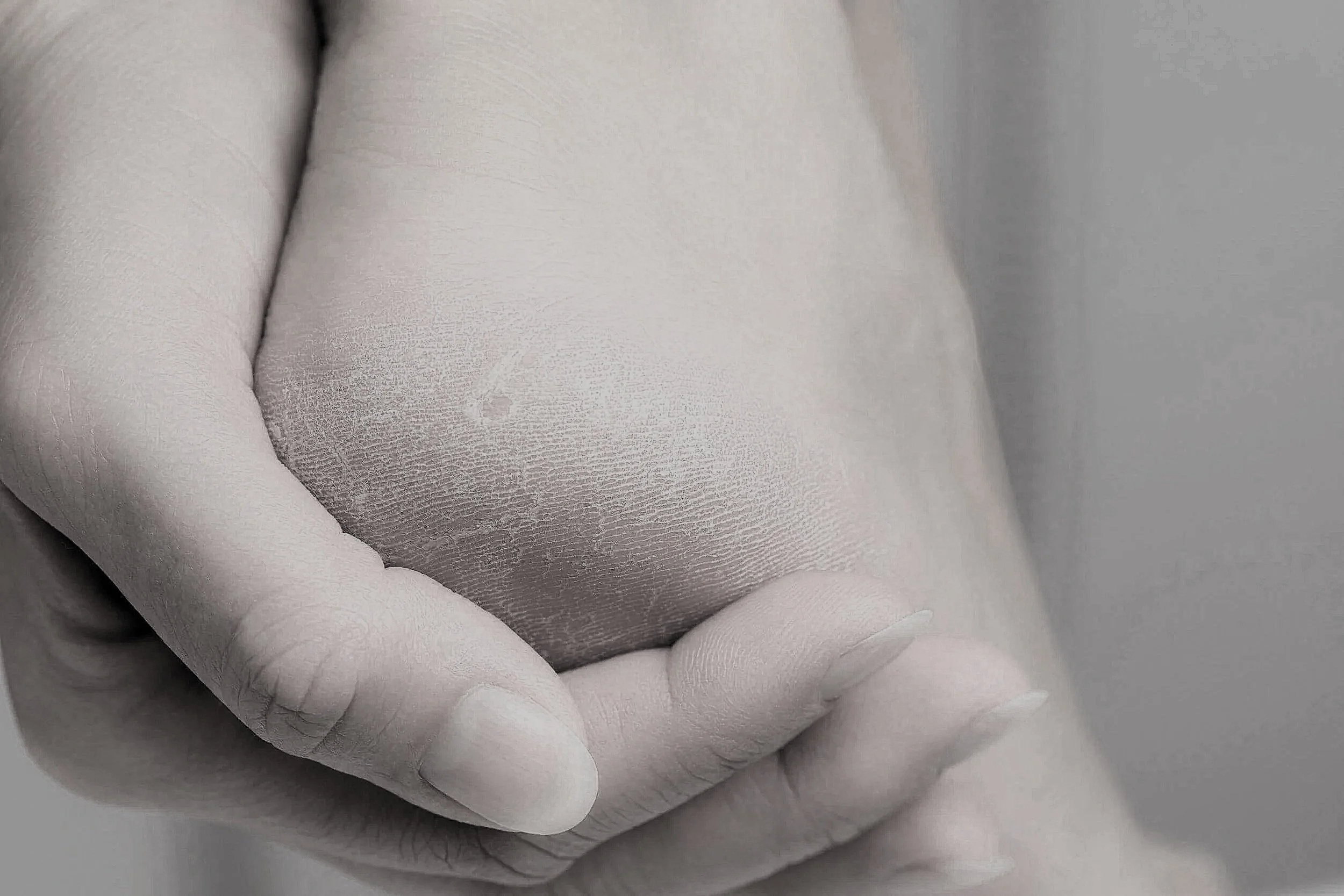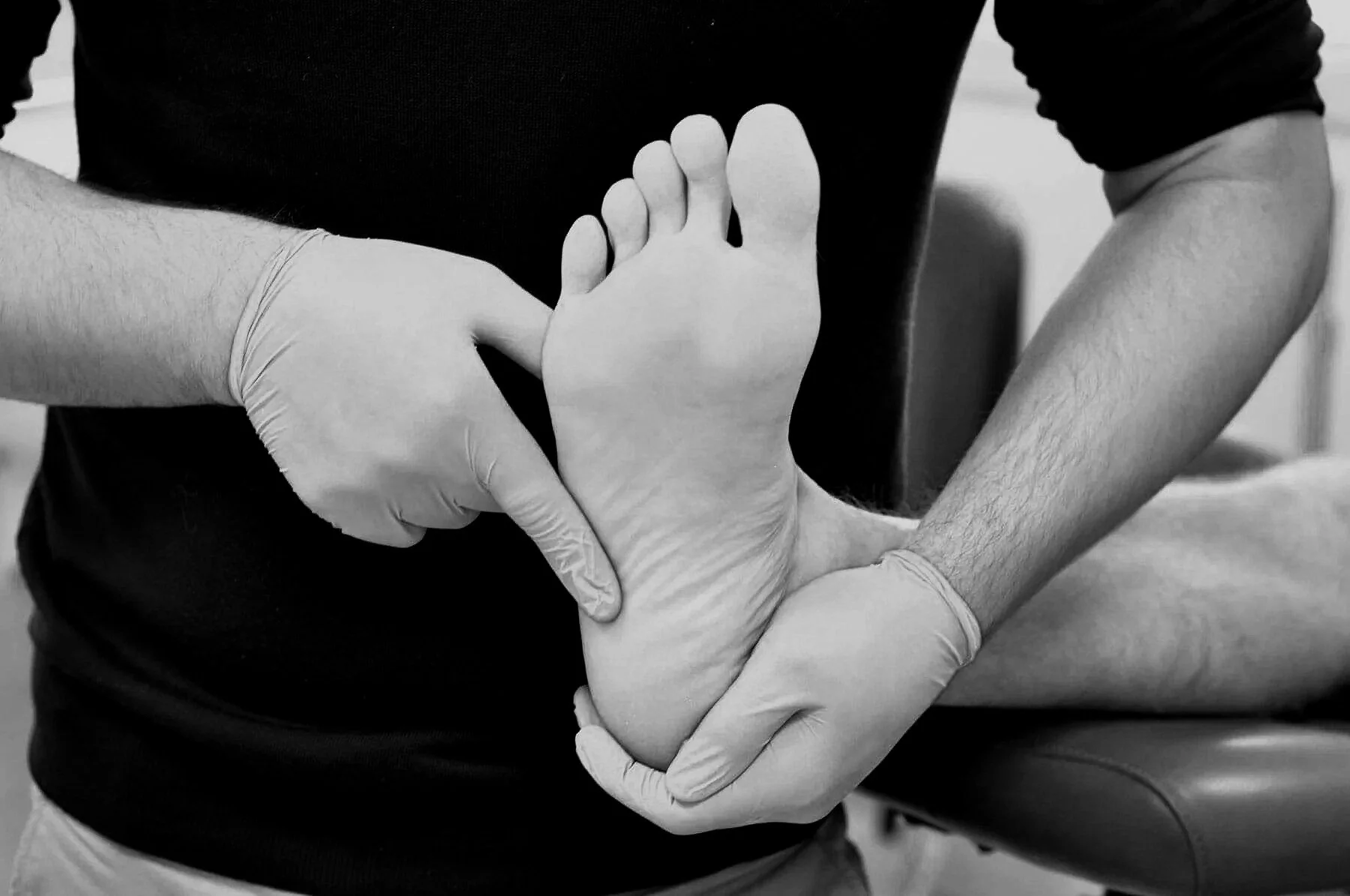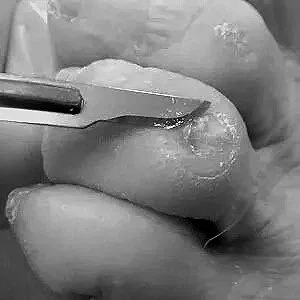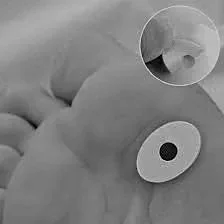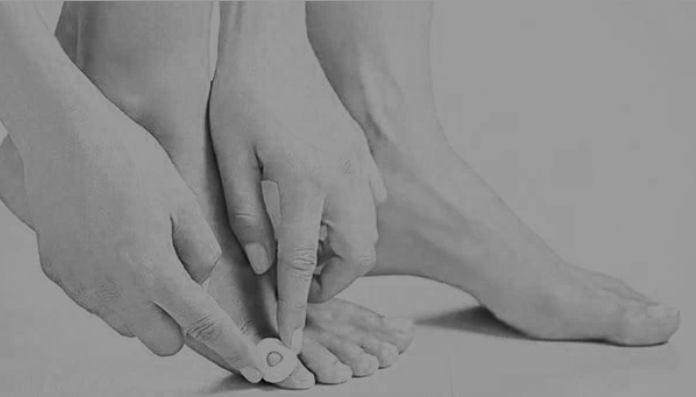CORNS & CALLUSES |
CORNS & CALLUSES |
CORNS & CALLUSES
Corns: Small, thickened areas of skin that develop on the toes due to repeated friction or pressure. They often have a hard center surrounded by inflamed skin and can be painful, especially when pressure is applied.
Calluses: Larger, thicker areas of skin that form on the soles of the feet or other weight-bearing areas, resulting from repeated friction or pressure. Calluses are generally less painful than corns and have a rough, dry texture.
SYMPTOMS
CORNS
🔵 Thickened Skin with a Central Core:
🔹Smaller, round, or cone-shaped patches of thick skin, often with a hard center (core).
🔹Typically found on the toes, especially over bony prominences (e.g., the tops, sides, or between toes).
🔵 Pain and Tenderness:
🔹Corns can be painful, especially when pressure is applied, such as when wearing shoes or walking.
🔹The center of the corn may press on underlying tissue, causing irritation.
🔵Hard or Soft Corns:
🔹Hard Corns: Typically found on the tops and sides of the toes, causing pain and discomfort.
🔹Soft Corns: Often found between the toes and are more likely to be painful due to moisture.
🔵 Redness or Inflammation:
🔹Corns may be accompanied by irritation, redness, or swelling around the affected area, particularly if they are squeezed or rubbed by shoes.
CALLUSES
🔵 Thickened Skin:
🔹Typically larger, flat, and rough areas of skin that develop on weight-bearing parts of the feet, such as the soles, heels, or balls of the feet.
🔹The skin appears yellowish or grayish in color.
🔵 Dry, Hard Skin:
🔹The affected area may feel dry, hard, and rough to the touch.
🔹May become flaky or cracked if it becomes too thick.
🔵 Minimal Pain:
🔹Calluses are usually not painful but can cause discomfort if they become too thick or press against shoes.
🔵No Defined Center:
🔹Calluses lack a central core and are generally more spread out and less defined than corns.
CAUSES & RISK FACTORS
CORNS
Corns develop due to repeated friction and pressure on the skin, typically from tight, ill-fitting shoes, or foot deformities. Common causes include:
🔵Improper Footwear: Tight, narrow shoes or high heels that apply pressure on the toes.
🔵Foot Abnormalities: Conditions like bunions, hammer toes, or high arches that cause uneven pressure.
🔵Repetitive Friction: Activities like running or dancing that put continuous pressure on the feet.
🔵Moisture: Sweaty feet or moisture between the toes that soften the skin, leading to soft corns.
Risk factors include aging, foot deformities, poor foot hygiene, and medical conditions such as diabetes.
CALLUSES
Calluses form due to repeated friction, pressure, or irritation on the skin, often from:
🔵Improper Footwear: Tight, loose, or ill-fitting shoes, especially high heels or narrow shoes.
🔵Repetitive Activities: Long periods of walking, running, or standing.
🔵Abnormal Foot Mechanics: Conditions like bunions, hammer toes, flat feet, or high arches can cause uneven pressure.
🔵Walking Barefoot: Walking on rough surfaces or hiking can lead to callus formation.
🔵Moisture: Excessive moisture or sweat increases friction, leading to calluses.
Risk factors include improper footwear, foot deformities, aging, obesity, poor foot hygiene, and medical conditions like diabetes or neuropathy.
DIAGNOSIS & TESTS
CORNS are typically diagnosed through a physical examination and patient history. A healthcare provider will assess the appearance of the corn and any associated symptoms. The diagnostic process includes:
🔵Physical Examination:
🔹Appearance: Corns are characterized by thickened, hardened skin, often with a central core that may be hard or soft.
🔹Location: Corns usually appear on the top, side, or between the toes, where there is pressure from shoes or toe misalignment.
🔹Pain: Corns are often tender or painful, especially when pressure is applied, which can help distinguish them from other skin conditions.
🔵Patient History: The healthcare provider will ask about footwear, activity levels, and any foot deformities (e.g., bunions, hammer toes) that might contribute to the formation of corns.
🔹The history of repetitive pressure or friction on the feet, such as wearing shoes that do not fit properly, will also be considered.
TEST FOR CORNS
In most cases, corns are diagnosed clinically without the need for additional tests. However, in certain situations, further evaluation may be recommended:
🔵 X-rays:
🔹If a corn is associated with foot deformities (e.g., bunions or hammer toes), an X-ray may be used to evaluate bone structure and identify abnormal toe alignment or other structural issues.
🔵Biopsy:
🔹In rare cases, if there is uncertainty about the diagnosis or the corn appears suspicious, a biopsy may be performed to rule out other conditions such as warts, tumors, or other growths.
🔵Skin Culture:
🔹If there are signs of infection (e.g., redness, drainage), a skin culture might be taken to identify any bacterial infection.
CALLUSES are usually diagnosed based on a physical examination and the patient’s history. The doctor will evaluate the appearance and location of the callus, as well as any associated symptoms (like pain or discomfort). The key diagnostic aspects include:
🔵Physical Examination:
🔹Appearance: The skin will appear thickened, rough, yellowish or grayish, typically on weight-bearing areas such as the soles, heels, or balls of the feet.
🔹Texture: The area may feel dry and hard to the touch.
🔹Size: Calluses may vary in size depending on the duration and intensity of friction or pressure.
🔵Patient History:
🔹A thorough history of footwear, activity levels, and any pre-existing foot conditions (e.g., bunions or flat feet) helps determine the underlying cause.
🔹A history of repetitive activities like walking, running, or standing for long periods can help identify contributing factors.
TEST FOR CALLUSES
In most cases, further testing is not required for calluses, as they can usually be diagnosed through visual examination and patient history. However, in certain cases, additional tests may be considered to rule out other conditions:
🔵X-rays:
🔹If the callus is associated with a foot deformity (such as a bunion or hammer toe), an X-ray may be used to check for structural abnormalities.
🔵Biopsy:
🔹Rarely, if there is concern that the callus could be a sign of another skin condition (such as a wart or tumor), a biopsy may be taken to rule out other possibilities.
🔵Pressure Mapping:
🔹For individuals with recurrent or severe calluses, a pressure mapping test may be used to identify areas of excessive pressure or abnormal gait patterns that contribute to callus formation.
MANAGEMENT & TREATMENT
CORNS can be managed with the following approaches:
🔵Conservative Treatment:
🔹Wear properly fitting shoes with enough room and cushioning to reduce pressure.
🔹Regularly soak and exfoliate feet to remove hardened skin.
🔹Use OTC salicylic acid treatments or corn cushions to relieve pressure and soften the corn.
🔵Medical Treatment:
🔹Podiatrist can remove the corn through debridement.
🔹Orthotics may be prescribed for structural issues.
🔹In case of infection or inflammation, antibiotics or corticosteroid injections may be used.
🔹In severe cases, surgery may be needed to correct underlying foot deformities.
CALLUSES can be managed with the following approaches:
🔵 Conservative Treatment:
🔹Wear properly fitted shoes and use cushioned insoles to reduce pressure.
🔹Soak feet in warm water and exfoliate using a pumice stone or foot file.
🔹Apply moisturizers to keep the skin hydrated and soft.
🔹Use OTC salicylic acid products to soften and remove calluses (with caution if you have diabetes or poor circulation).
🔵 Medical Treatment:
🔹A podiatrist may perform professional debridement to remove thickened skin.
🔹Custom orthotic inserts can address foot deformities and prevent further callus formation.
🔹Corticosteroid injections may be used for pain and inflammation.
PREVENTION
CORNS
➡️ Wear well-fitting shoes: Choose shoes with enough room in the toe box and avoid tight, narrow, or high-heeled footwear.
➡️Use protective pads: Gel pads or corn cushions can help reduce friction and pressure on affected areas.
➡️Practice good foot hygiene: Soak and exfoliate feet regularly to remove thickened skin and keep feet soft.
➡️Address foot deformities: Correct issues like bunions or hammertoes with orthotics or medical treatment to reduce pressure.
➡️Inspect feet regularly: Check for early signs of corns and address them before they worsen.
CALLUSES
➡️Wear properly fitting shoes: Ensure shoes have enough room in the toe box and provide cushioning to reduce pressure on the feet.
➡️Use protective footwear: Cushioned insoles or toe protectors can help reduce friction and pressure.
➡️Practice good foot care: Soak and exfoliate feet regularly to remove thickened skin and moisturize to keep skin soft.
➡️Address foot deformities: Treat conditions like bunions or high arches with orthotics or medical intervention to prevent excessive pressure.
➡️Reduce prolonged pressure and friction: Take breaks from standing, wear breathable socks, and avoid prolonged foot pressure.
PROGNOSIS
CORNS
1️⃣Proper Treatment:
🔹Most corns can be successfully treated with conservative measures like wearing properly fitting shoes, using cushioning pads, and regular exfoliation. Over-the-counter treatments, like salicylic acid, can help soften and remove the thickened skin.
🔹Debridement by a healthcare professional may be necessary for larger or more painful corns.
2️⃣Underlying Conditions:
🔹If corns are caused by foot deformities (e.g., bunions or hammertoes), treating the underlying condition is essential for long-term relief. In some cases, surgery may be needed to correct structural issues.
🔹Individuals with diabetes or poor circulation should take extra care in managing corns, as they are at a higher risk of complications, such as infection or ulceration, if corns are not treated promptly.
CALLUSES
1️⃣Proper Treatment:
🔹Calluses can usually be managed successfully with conservative treatments, including wearing well-fitting shoes, regular soaking and exfoliating, and using moisturizers to soften the skin.
🔹If calluses are causing pain or discomfort, professional debridement by a healthcare provider can be effective in removing the thickened skin.
2️⃣ Underlying Conditions:
🔹If calluses are caused by foot deformities, such as bunions or high arches, addressing the root cause with orthotics or corrective surgery may be necessary for long-term relief.
Corns and calluses are manageable conditions that, with proper care, can significantly improve foot comfort and functionality. Regular podiatric evaluations, along with preventive measures such as appropriate footwear and foot hygiene, are key to maintaining healthy feet and preventing recurrence. Consult your podiatrist for personalized care and treatment options tailored to your specific needs.



